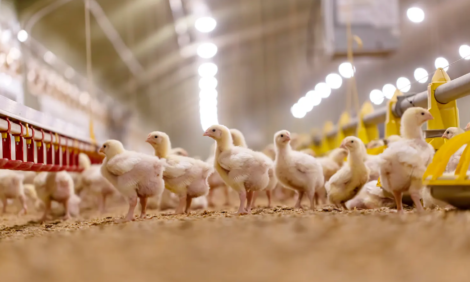



EU Egg Production Beyond the 2012 Cage Ban
Some EU countries will fail to meet the 2012 cage ban, writes Terry Evans for ThePoultrySite.While the move out of conventional cages to less intensive layer systems continues among European Union countries, it is most unlikely that all members states will have got rid of conventional cages by the deadline of 1 January 2012.
Between 2007 and 2008, barn and free-range egg production systems gained in popularity at the expense of conventional cages in almost half of the countries reporting in the International Egg Commission's International Egg Market Annual Review (see table below). However, it should be noted that this change is evident almost exclusively in EU member states, the exceptions being Columbia and Japan.
As a result of the European Union Directive 1999/74/EC, which laid down management standards for laying hens, and the decision by the EU Commission in 2008 that the regulations in the Directive would not be altered, a ban on conventional layer cages will become effective in EU member countries from 1 January 2012. Hence, by that deadline, conventional layer cages must be replaced by either so-called enriched cages or by alternative, less intensive production systems such as barn and free-range. EU member countries were allowed to pass stricter regulations; in Germany, conventional cages were banned in 2009, while in Austria the ban will be enforced from 2010.
To meet the costs of implementing the Directive by 2012, it has been estimated that more than €6 billion will be required. Professor Hans-Wilhelm Windhorst, the International Egg Commission's Statistical Analyst has observed that it is not realistic to assume that this amount of capital will be forthcoming. So, it remains to be seen how the Commission will react when layers will continue to be housed in conventional cages in EU countries after the 2012 deadline!
All commercial layers are kept in conventional cages in Brazil, India, Iran, Mexico, the Ukraine and the United Arab Emirates, while in Canada, Greece, Italy, Spain and the USA, 90 per cent or more of the national flock is housed in this manner.
In Argentina, the proportion of the flock kept in cages actually increased in 2008 from 93.5 to 96.0 per cent at the expense of free-range production, which contracted from 5.0 per cent to 2.5 per cent.
The move away from cages continued in the UK, such that the proportion of the flock in free-range systems rose to almost 38 per cent, from 34 per cent in 2007, and is now higher than in any other IEC member country with the exception of Switzerland where cage eggs have been banned for some time.
The proportion of birds in cages in the Netherlands has continued to decline to a new 'low' of 45 per cent, production in barn systems benefiting by reaching 41 per cent. Most of the cage eggs are exported, such that at the domestic consumption level, cage eggs represent only 11 per cent of the total.
In Austria and Sweden, around 60 per cent of the flock is now housed in barns. While some 40 per cent of the flock in Sweden is in cages, they are in enriched and not conventional cages.
All conventional cages were banned in Germany this year. However, as leading German retailers have decided to stock only eggs from non-cage systems, those producers who have converted to colony cage systems are finding it extremely difficult to find market outlets. In Australia, roughly one in five eggs come from a free-range system.
Barn production systems have become more popular in several of the countries covered by the IEC survey and in particular, Columbia where they account for 10 per cent of the flock, Cyprus (15 per cent), Germany (21.7 per cent), Hungary (16 per cent), Japan (seven per cent) and the Netherlands (41 per cent).
| Layer management systems in IEC member countries (%) | |||||||
|---|---|---|---|---|---|---|---|
| Layers | 2007 | 2008 | |||||
| Country | (millions) | Cages | Barn | Free- range |
Cages | Barn | Free- range |
| Argentina | 30.5 | 93.5 | 1.5 | 5.0 | 96.0 | 1.5 | 2.5 |
| Australia | 14.2 | 78.0 | 5.0 | 17.0 | 77.0 | 5.0 | 18.0 |
| Austria | 5.3 | 20.0 | 50.0 | 30.0 | 10.0 | 60.0 | 30.0 |
| Belgium | 8.9 | 87.0 | 8.0 | 5.0 | - | - | - |
| Brazil | 78.7 | 100.0 | 0.0 | 0.0 | 100.0 | 0.0 | 0.0 |
| Canada | 26.0 | 98.0 | 1.0 | 1.0 | 98.0 | 1.0 | 1.0 |
| China | 1350.0 | - | - | - | 70.0 | - | 30.0 |
| Columbia | 39.8 | 100.0 | 0.0 | 0.0 | 90.0 | 10.0 | 0.0 |
| Cyprus | 0.4 | 84.0 | 11.0 | 6.0 | 80.0 | 15.0 | 5.0 |
| Czech Rep | 10.8 | 70.0 | 0.0 | 30.0 | 70.0 | 0.0 | 30.0 |
| Denmark | 3.2 | 59.0 | 20.0 | 21.0 | 57.5 | 19.9 | 22.6 |
| Finland | 3.3 | 80.0 | 20.0 | 0.0 | 78.0 | 19.0 | 3.0 |
| France | 44.2 | 81.0 | 3.0 | 16.0 | 81.0 | 3.0 | 16.0 |
| Germany | 38.5* | 67.5 | 17.0 | 15.5 | 62.0 | 21.7 | 16.3 |
| Greece | 5.2 | 90.0 | 8.0 | 2.0 | 90.0 | 8.0 | 2.0 |
| Hungary | 4.0 | 88.0 | 11.5 | 0.5 | 83.0 | 16.0 | 1.0 |
| India | 150.4 | 100.0 | 0.0 | 0.0 | 100.0 | 0.0 | 0.0 |
| Iran | 37.0 | 100.0 | 0.0 | 0.0 | 100.0 | 0.0 | 0.0 |
| Ireland | 2.0 | 66.0 | 1.5 | 33.5 | 62.4 | 1.0 | 36.6 |
| Italy | - | 90.7 | 7.0 | 2.3 | 90.7 | 7.0 | 2.3 |
| Japan | 142.5 | 95.0 | 4.0 | 1.0 | 91.0 | 7.0 | 2.0 |
| Mexico | 131.1 | 100.0 | 0.0 | 0.0 | 100.0 | 0.0 | 0.0 |
| Netherlands | 31.1 | 48.0 | 37.0 | 15.0 | 45.0 | 41.0 | 14.0 |
| New Zealand | 3.2 | 89.0 | 2.0 | 9.0 | 88.9 | 1.4 | 9.7 |
| Norway | 3.0* | 60.0 | 21.0 | 19.0 | - | - | - |
| Portugal | 5.5 | 99.0 | 0.5 | 0.5 | - | - | - |
| Slovakia | 5.6 | - | - | - | 70.0 | 0.0 | 30.0 |
| South Africa | 23.1 | 86.0 | 0.0 | 14.0 | 86.0 | 0.0 | 14.0 |
| Spain | 40.4 | 97.0 | 2.0 | 1.0 | 97.0 | 1.2 | 1.8 |
| Sweden | 5.9 | 39.5 | 60.5 | 0.0 | 40.5 | 59.5 | 0.0 |
| Switzerland | 2.0 | 0.0 | 35.0 | 65.0 | 0.0 | 35.0 | 65.0 |
| Ukraine | 29.0 | 100.0 | 0.0 | 0.0 | 100.0 | 0.0 | 0.0 |
| United Arab Emirates | 1.7 | 100.0 | 0.0 | 0.0 | 100.0 | 0.0 | 0.0 |
| United Kingdom | 29.1 | 62.0 | 4.0 | 34.0 | 58.3 | 3.8 | 37.9 |
| United States | 282.6 | 95.0 | 4.5 | 0.5 | 95.0 | 4.5 | 0.5 |
Source: IEC's International Egg Market Annual Review
December 2009








